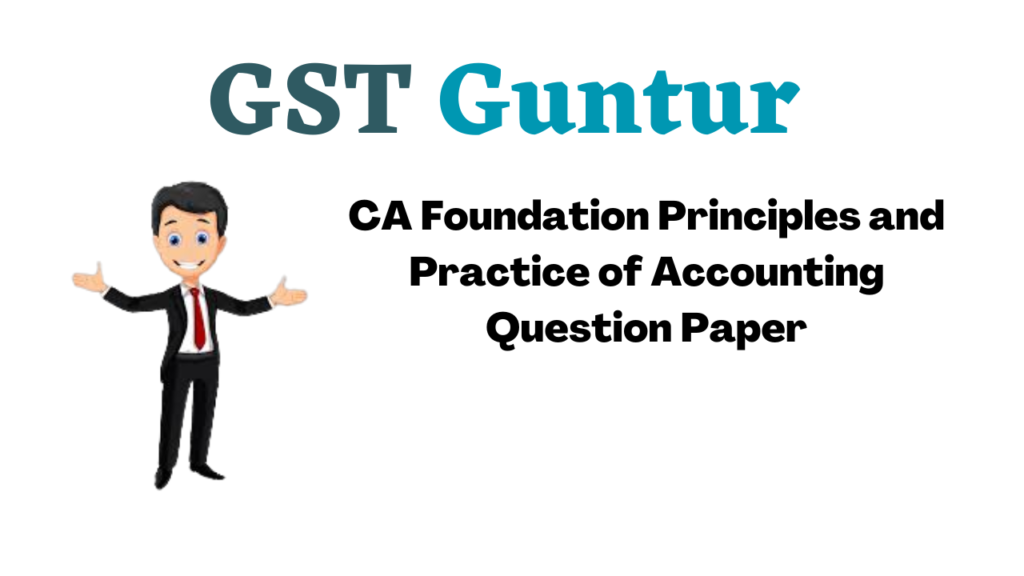These CA Foundation Accounts Study Material CA Foundation Principles and Practice of Accounting Question Paper is designed strictly as per the latest syllabus and exam pattern.
CA Foundation Principles and Practice of Accounting Question Paper
Question No. 1 is compulsory.
Candidates are also required to answer any four questions from the remaining five questions.
Working notes should form part of the respective answers.
Question 1(a).
State with reasons, whether the following statements are True or False. [6 Statements x 2 = 12 Marks]
(i) In case of admission of a new partner in a partnership firm, the profit/ loss on revaluation account is transferred to all partners in their new profit sharing ratio.
(ii) In the balance sheet of X Limited, preliminary expenses amounting to ₹ 5 lakhs and securities premium account of ₹ 35 lakhs are appearing. The accountant can use the balance in securities premium account to write off preliminary expenses.
(iii) Insurance claim received on account of plant and machinery completely damaged by fire is a capital receipt.
(iv) Purchase of office furniture & fixtures of ₹ 2,500 has been debited to General Expense Account. It is an error of omission.
(v) A Limited is sending goods costing ₹ 50,000 to B Limited on consignment basis. The accountant of A Limited is of the opinion that these goods should be sent under a sale invoice.
(vi) A concern proposes to discontinue its business from December, 2020 and decides to dispose of all its plants within a period of 3 months. The Balance Sheet as on 31st December, 2020 should continue to indicate the plants at its historical costs as the assets will be disposed of after the Balance Sheet date.
Answer:
(i) False: Profit & Loss on Revaluation account is transferred to old partners only in their old ratio.
(ii) True: Section 52 of the Companies Act, 2013 allows that preliminary expenses may be written off through Securities Premium Account.
(iii) True: It is a Capital receipt because it is received against a Capital expenditure.
(iv) False: It is an error of Principle.
(v) False: In Consignment basis when goods are sent to agent for the purpose of sale, a Proforma invoice is prepared because consignor transfers only possession of goods not the ownership of goods.
(vi) False: As per going concern concept any business shows its Fixed Assets at its historical cost but in case of discontinuance of business they should be shown at their expected realizable value.
![]()
Question 1(b).
What services can a Chartered Accountant provide to the society? (4 Marks)
Answer:
Role of accountant in the society:
→ An accountant with his education, training, analytical mind and experience is best qualified to provide multiple need-based service to the ever-growing society.
→ The accountants of today can do full justice not only to matters relating to taxation, costing, management accounting, financial planning, company law and procedures but they can act in the fields relating to financial policies, budgetary policies, information technology, Software development and even economic principles.
→ The services rendered by accountants to the society include the following:
- To maintain the Books of Account in a systematic manner.
- To act as a Statutory Auditor (for example under the Companies Act, Income Tax Act, Co-operative Societies Act).
- To act as an Internal Auditor.
- To act as Social Auditor.
- To act as Taxation Advisor.
- To act as Management Accountant.
- To act as Financial Advisor.
- To provide Management Consultancy Services.
- To act as Company Law Advisor.
- To act as Liquidator.
- To act as Arbitrator.
- To act as Management Information System Consultant.
- To act in the held of software development.
Question 1(c).
The following are some of the transactions of M/s. Kamal & Sons for the year ended 31st March, 2020. You are required to make out their Sales Book.
(i) Sold to M/s. Ashok & Mukesh on Credit:
40 Shirts @ ₹ 900 per shirt
30 trousers @ ₹ 1,000 per trouser
Less: Trade discount @10%
(ii) Sold furniture to M/s. XYZ & Co. on credit ₹ 8,000
(iii) Sold 15 shirts to Aman @ ₹ 750 each for cash. (4 Marks)
Answer:
In the books of M/s. Kamal & Sons
Sales Book

Note:
- Furniture sold on credit is not sale of goods, so it will not be recorded in Sales Book.
- Goods sold in cash are not recorded in Sales Book.
![]()
Question 2(a).
On 31-3-2020, Mahesh’s Cash Book Showed a Bank overdraft of ₹ 98,700. On comparison he finds the following :
(1) Out of the total cheques of ₹ 8,900 issued on 27th March, one cheque of ₹ 7,400 was presented for payment on 4th April and the other cheque of ₹ 1,500 handed over to the customer, was returned by him and in lieu of that a new cheque of the same amount was issued to him on 1st April. No entry for the return was made.
(2) Out of total cash and cheques of ₹ 6,800 deposited in the Bank on 24th March, one cheque of ₹ 2,600 was cleared on 3rd April and the other cheque of ₹ 500 was returned dishonoured by the bank on 4th April.
(3) Bank charges ₹ 35 and Bank interest ₹ 2,860 charged by the bank appearing in the passbook are not yet recorded in the cash book.
(4) A cheque deposited in his another account of ₹ 1,550 wrongly credited to this account by the bank.
(5) A cheque of f 800, drawn on this account, was wrongly debited in another account by the bank.
(6) A debit of ₹ 3,500 appearing in the bank statement for an unpaid cheque returned for being ‘out of date’ had been re-dated and deposited in the bank account again on 5th April 2020.
(7) The bank allowed interest on deposit ₹ 1,000.
(8) A customer who received a cash discount of 4% on his account of ₹ 1,00,000 paid a cheque on 20th March, 2020. The cashier erroneously entered the gross amount in the bank column of the Cash Book.
Prepare Bank Reconciliation Statement as on 31-3-2020. (10 Marks)
Answer:
Bank Reconciliation Statement as on 31st March, 2020
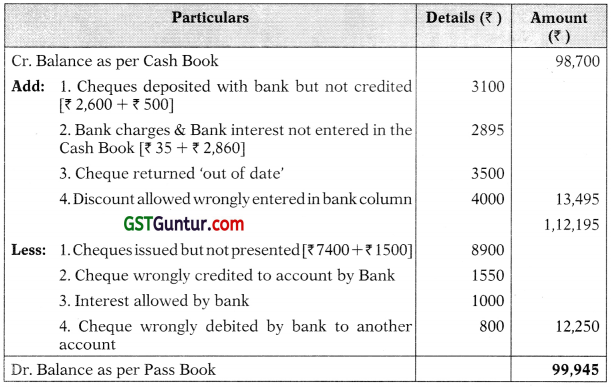
Question 2(b).
Physical verification of stock in a business was done on 23rd February, 2020. The value of the stock was ₹ 28,00,000. The following transactions took place from 23rd February to 29th February, 2020:
(1) Out of the goods sent on consignment, goods at cost worth ₹ 2,30,000 were unsold.
(2) Purchases of ₹ 3,00,000 were made out of which goods worth ₹ 1,20,000 were delivered on 5th March, 2020.
(3) Sales were ₹ 13,60,000 which include goods worth ₹ 3,20,000 sent on approval. Half of these goods were returned before 29th February, 2020, but no information is available regarding the remaining goods.
(4) Goods are sold at cost plus 2596. However goods costing ₹ 2,40,000 had been sold for ₹ 1,50,000.
Determine the value of stock on 29th February, 2020. (10 Marks)
Answer:
Statement of Valuation of Stock on 29th Feb., 2020
| ₹ | ₹ | |
| Value of stock as on 23rd Feb. 2020 | 28,00,000 | |
| Add: Unsold stock out of the goods sent on consignment | 2,30,000 | |
| Purchases during the period from 23 Feb., 2020 to 29 Feb., 2020 | 1,80,000 | |
| Goods in transit on 29 Feb., 2020 | 1,20,000 | 5,30,000 |
| 33,30,000 | ||
| Less: Cost of sales during the period from 23 Feb., 2020 to 29 Feb., 2020 (W.N.1) | (9,52,000) | |
| 23,78,000 |
Working Notes:
1. Calculation of Cost of Sales:
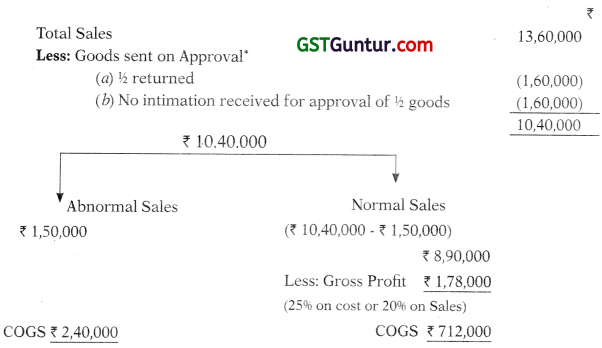
Total COGS is ₹ 9,52,000 (₹ 2,40,000 + ₹ 7,12,000)
This stock is already included in stock taking made on 23rd Feb., 2020.
![]()
Question 3(a).
Maya consigned 400 boxes of shaving brushes, each box containing 100 shaving brushes. Cost price of each box was ₹ 3,000. Maya spent ₹ 500 per box as cartage, freight, insurance and forwarding charges. One box was lost on the way and Maya lodged claim with insurance company and could get ₹ 2,700 as claim on average basis. Consignee took delivery of the rest of the boxes and spent ₹ 1,99,500 as non-recurring expenses and ₹ 1,12,500 as recurring expenses. He sold 370 boxes at the rate of ₹ 65 per shaving brush. He was entitled to 2% commission on sales plus 1% del-credere commission.
You are required to prepare Consignment Account. (5 Marks)
Answer:
In the books of Maya
Consignment a/c
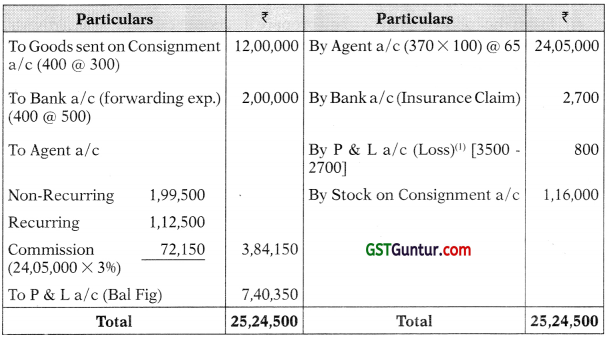
Working Note:
1.
| Calculation of abnormal loss: | ₹ |
| Original cost of 1 Box | 3,000 |
| + Proportionate forwarding expenses on 1 Box | 500 |
| 3,500 |
Note: Only forwarding expenses will be taken into consideration since goods are lost in transit.

Note : Non-recurring expenses of Agent were incurred on remaining boxes received by him.
Question 3(b).
Attempt any ONE of the following two sub-parts i.e. either (i) or (ii).
(i) From the following particulars prepare a account current, as sent by Mr. Raju to Mr. Sunil as on 31st October 2020 by means of product method charging interest @ 12% p.a.
| 2020 | Particulars | Amount ₹ |
| 1st July 15th August 20th August 22nd September 15th October |
Balance due from Sunil Sold goods to Sunil Goods returned by Sunil Sunil paid by Cheque Received cash from Sunil |
840 1,310 240 830 560 |
OR
(ii) Rakesh had the following bills receivable and bills payable against Mukesh.
| Date | Bills Receivable | Tenure | Date | Bills Payable | Tenure |
| 1st June 5th June 9th June 12th June 20th June |
3,400 2,900 5,800 1,700 1,900 |
3 month 3 month 1 month 2 month 3 month |
29th May 3rd June 9th June |
2,500 3,400 5,700 |
2 month 3 month 1 month |
15th August was a public holiday. However, 6th September, was also declared a sudden holiday.
Calculate the average due date, when the payment can be received or made without any loss of interest to either party. (5 Marks)
Answer:
(i) Mr. Sunil in account current with Mr. Raju
(Interest upto 31st October, 2020 @ 12% p.a.)

Note: Since year 2020 is a leap year, Interest is calculated on 366 days.
(ii) Bills receivable of Mr. Rakesh
Base date = 12th July

Bills payable for Mr. Rakesh
Base date = 12th July
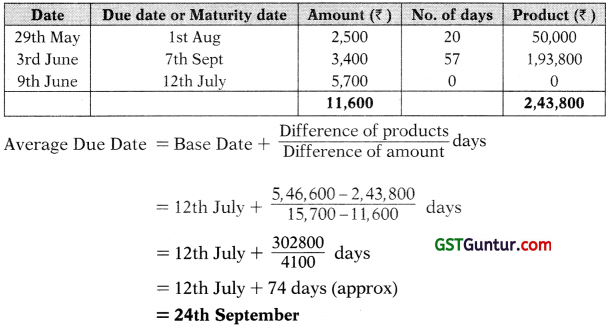
Question 3(c).
Suresh draws a bill for ₹ 15,000 on Anup on 15th April, 2020 for 3 months, which Anup returns to Suresh after accepting the same. Suresh gets it discounted with the bank for ₹ 14,700 on 18th April, 2020 and remits one-third amount to Anup. On the due date Suresh fails to remit the amount due to Anup, but he accepts a bill of ₹ 17,500 for 3 months, which Anup discounts for ₹ 17,100 and remits ₹ 2,825 to Suresh. Before the maturity of the renewed bill Suresh becomes insolvent and only 50% was realized from his estate on 31st October, 2020.
Pass necessary Journal entries for the above transactions in the books of Suresh. (10 Marks)
Answer:
In the books of Suresh
Journal Entries
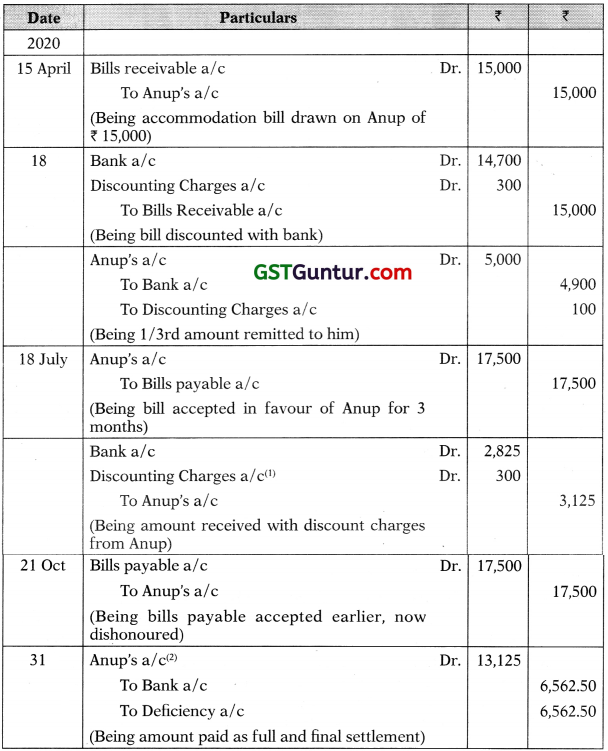
Working Note:
1. Share of Suresh in discounting charges of Second Bill
= 400 x \(\left(\frac{10000+2825}{171000}\right)\) = ₹ 300
2. Anup’s a/c

Question 4(a).
M/s. TB is a partnership firm with the partners A, B and C sharing profits and losses in the ratio of 3 : 2 : 5. The balance sheet of the firm as on 30th June, 2020 was as under:
Balance Sheet of M/s. TB as on 30-6-2020

It was mutually agreed that B will retire from partnership and in his place D will be admitted as a partner with effect from 1st July, 2020. For this purpose, following adjustments are to be made :
(a) Goodwill of the firm is to be valued at ₹ 3 lakhs due to the firm’s location advantage but the same will not appear as an asset in the books of the reconstituted firm.
(b) Building and Plant & Machinery are to be valued at 95% and 80% of the respective balance sheet values. Investments are to be taken over by the retiring partner at ₹ 46,000. Trade receivables are considered good only upto 85% of the balance sheet figure. Balance to be considered bad.
(c) In the reconstituted firm, the total capital will be ₹ 4 lakhs, which will be contributed by A, C and D in their new profit sharing ratio, which is 3 : 4 : 3.
(d) The amount due to retiring partner shall be transferred to his loan account.
You are required to prepare Revaluation Account and Partners’ Capital Accounts after reconstitution, along with working notes.
Answer:
Revaluation a/c

Partner’s Capital a/c
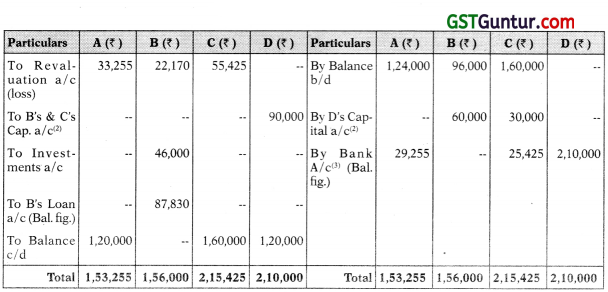
Working Notes:
1. Calculation of Sacrifice/Gain:
Old Share – New Share
A = \(\frac { 3 }{ 10 }\) – \(\frac { 3 }{ 10 }\) = NIL
B = \(\frac { 2 }{ 10 }\) – NIL = \(\frac { 2 }{ 10 }\) (Sacrifice)
C = \(\frac { 5 }{ 10 }\) – \(\frac { 4 }{ 10 }\) = \(\frac { 1 }{ 10 }\) (Sacrifice)
D = NIL – \(\frac { 3 }{ 10 }\) = – \(\frac { 3 }{ 10 }\)(Gain)
2. Goodwill Treatment:
(3,00,000 x 3/10) D’s Capital a/c Dr. 90,000
(3,00,000 x 2/10) To B’s Capital a/c 60,000
(3,00,000 x 1 /10) To C’s Capital a/c 30,000
3. Capital Adjustment:
Total Capital of the firm: ₹ 4,00,000
| A(\(\frac { 3 }{ 10 }\)) | C(\(\frac { 4 }{ 10 }\)) | C(\(\frac { 3 }{ 10 }\)) | |
| Capital in the New firm | ₹ 1,20,000 | ₹ 1,60,000 | ₹ 1,20,000 |
| Less: Capital balance | ₹ 90,745 | ₹ 1,34,575 | ₹ 1,20,000 |
| Short ₹ 29,255 | Short ₹ 25,425 | – |
![]()
Question 4(b).
From the following balances and particulars of AS College, prepare Income & Expenditure Account for the year ended March, 2020 and a Balance Sheet as on the date :
| Particulars | Amount (₹) |
Amount
(₹) |
| Security Deposit – Students | – | 1,55,000 |
| Capital Fund | – | 13,08,000 |
| Building Fund | – | 19,10,000 |
| Tuition Fee Received | – | 8,10,000 |
| Government Grants | – | 5,01,000 |
| Interest & Dividends on Investments | – | 1,75,000 |
| Hostel Room Rent | – | 1,65,000 |
| Mess Receipts (Net) | – | 2,05,000 |
| College Stores – Sales | – | 7,60,000 |
| Outstanding expenses | – | 2,35,000 |
| Stock of Stores and Supplies (opening) | 3,10,000 | – |
| Purchases – Stores & Supplies | 8,20,000 | – |
| Salaries – Teaching | 8,75,000 | – |
| Salaries – Research | 1,25,000 | – |
| Scholarships | 85,000 | – |
| Students Welfare expenses | 37,000 | – |
| Games & Sports expenses | 52,000 | – |
| Other investments | 12,75,000 | – |
| Land | 1,50,000 | – |
| Building | 15,50,000 | – |
| Plant and Machinery | 8,50,000 | – |
| Furniture and Fittings | 5,40,000 | – |
| Motor Vehicle | 2,40,000 | – |
| Provision for Depreciation: | – | |
| Building | – | 4,90,000 |
| Plant & Equipment | – | 5,05,000 |
| Furniture & Fittings | – | 3,26,000 |
| Cash at Bank | 3,16,000 | |
| Library | 3,20,000 | |
| 75,45,000 | 75,45,000 |
Adjustments:
(a) Materials & Supplies consumed : (From college stores)
Teaching – ₹ 52, 000
Research – ₹ 1,45,000
Students Welfare – ₹ 78,000
Games or Sports – ₹ 24,000
(b) Tuition fee receivable from Government for backward ₹ 82,000.
(c) Stores selling prices are fixed to give a net profit of 15% on selling price.
(d) Depreciation is provided on straight line basis at the following rates :
Building 5%
Plant & Equipment 10%
Furniture & Fixtures 10%
Motor Vehicle 20% (10 Marks)
Answer:
Income & Expenditure account of AS College
for the year ended on 31st March, 2020
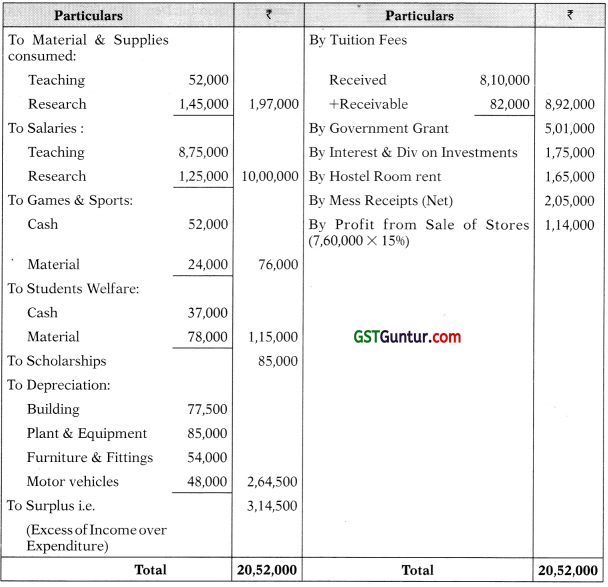
Balance Sheet of AS College as at 31st March, 2020
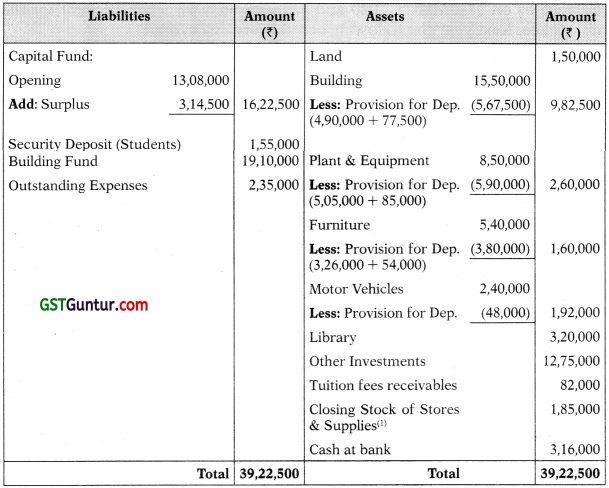
Working Note:
1. Calculation of Closing Stock of Stores & Supplies :

Question 5(a).
M/s. Applied Laboratories were unable to agree the Trial Balance as on 31st March, 2020 and have raised a suspense account for the difference. Next year the following errors were discovered :
(i) Repairs made during, the year were wrongly debited to the building A/c – ₹ 12,500.
(ii) The addition of the ‘Freight’ column in the purchase journal was short by ₹ 1,500.
(iii) Goods to the value of ₹ 1,050 returned by a customer, Rani & Co., had been posted to the debit of Rani & Co. and also to sales returns.
(iv) Sundry items of furniture sold for 130,000 had been entered in the sales book, the total of which had been posted to sales account.
(v) A bill of exchange (received from Raja & Co.) for ₹ 20,000 had been returned by the bank as dishonoured and had been credited to the bank and debited to bills receivable account.
You are required to pass journal entries to rectify the above mistakes. (5 Marks)
Answer:
In the books of M/s. Applied Laboratories
Rectification Journal Entries

Working Note:
1. Profit & Loss Adjustment a/c
| Particulars | ₹ | Particulars | ₹ |
| To Building a/c To Suspense a/c To Furniture a/c |
12,500
1,500 30,000 |
By Capital a/c (Bal. fig.) (Loss on adjustment) |
44,000 |
| Total | 44,000 | Total | 44,000 |
Question 5(b).
Max & Co. employs a team of 9 worker who were paid ₹ 40,000 per month each in the year ending 31st December, 2018. At the start of 2019, the company raised salaries by 10% to ₹ 44,000 per month each.
On 1st July, 2019 the company hired 2 trainees at salary of ₹ 21,000 per month each. The work force are paid salary on the first working day of every month, one month in arrears, so that the employees receive their salary for January on the first working day of February, etc.
You are required to calculate :
- Amount of salaries which would be charged to the profit and loss for the year ended 31st December, 2019.
- Amount actually paid as salaries during 2019.
- Outstanding salaries as on 31st December, 2019. (5 Marks)
Answer:
(i) Amount of Salaries which would be charged to the Profit and Loss for the year ended 31st Dec., 2019
| Amount (₹) | |
| For 9 Existing workers (9 x ₹ 44,000 x 12)
For 2 New trainees (2 x ₹ 21000 x 6) |
47,52,000
2,52,000 |
| Total | 50,04,000 |
(ii) Amount Actually paid as Salaries during 2019
| Amount (₹) | |
| (a) For 9 workers for Dec., 2018 (9 x ₹ 40,000 x 1)
(b) For 9 workers from Jan., to Nov., 2019 (9 x ₹ 44,000 x 11) (c) For 2 New trainees from July to Nov., 2019 (2 x ₹ 21,000 x 5) |
3,60,000
43,56,000 2,10,000 |
| Total | 49,26,000 |
(iii) Outstanding Salaries as on 31st Dec., 2019
| Amount (₹) | |
| (a) For 9 Workers for Dec., 2019 (₹ 44,000 x 9)) | 3,96,000 |
| (b) For 2 New trainees for Dec., 2019 (₹ 21,000 x 2) | 42,000 |
| Total | 4,38,000 |
![]()
Question 5(c).
Following are the Manufacturing A/c, Creditors A/c and Trading A/c provided by M/s. Shivam related to financial year 2019-20. There are certain figures missing from these accounts.
Raw Material A/c
| Particulars | Amount (₹) |
Particulars | Amount (₹) |
| To Opening Stock A/c | 1,27,000 | By Raw Materials Consumed | – |
| To Creditors A/c | – | By Closing Stock | – |
Creditors A/c
| Particulars | Amount (₹) |
Particulars | Amount (₹) |
| To Bank A/c | 23,50,000 | By Balance b/d | 15,70,000 |
| To Balance A/c | 6,60,00 | – |
Manufacturing A/c
| Particulars | Amount (₹) |
Particulars | Amount (₹) |
| To Raw Material A/c
To Wages To Depreciation To Direct Expenses |
3,65,000
2,15,000 2,49,000 |
By Trading A/c | 17,44,000 |
Additional Information:
(i) Purchase of machinery worth ₹ 12,00,000 on 1st April, 2019 has been omitted. Machinery are chargeable at a depreciation rate of 15%.
(ii) Wages include the following:
Paid to factory workers – ₹ 3,15,000
Paid to labour at office – ₹ 50,000
(iii) Direct expenses including following :
Electricity charges – ₹ 80,000 of which 25% pertained to office
Fuel charges – ₹ 25,000
Freight inwards – ₹ 32,000
Delivery charges to customers – ₹ 22,000
You are required to prepare revised Manufacturing A/c and Raw Material A/c. (10 Marks)
Answer:
Raw Material A/c
| Particulars | Amount (₹) |
Particulars | Amount (₹) |
| To Opening Stock A/c | 1,27,000 | By Raw Materials Consumed | 9,15,000 |
| To Creditors A/c | 14,40,000 | By Closing Stock | 6,52,000 |
| Total | 15,67,000 | Total | 15,67,000 |
Creditors A/c
| Particulars | Amount (₹) |
Particulars | Amount (₹) |
| To Bank A/c | 23,50,000 | By Balance b/d | 15,70,000 |
| To Balance A/c | 6,60,00 | By Purchase of raw material (bal. fig) | 14,40,000 |
| Total | 30,10,000 | Total | 30,10,000 |
Revised Manufacturing A/c
| Particulars | Amount (₹) | Particulars | Amount (₹) |
| To Raw Material A/c
To Wages(3,65,000-50,000) To Depreciation(1) To Direct Expenses(2) |
9,15,000
3,15,000 3,95,000
|
By Trading a/c(3) | 18,32,000 |
| Total
|
18,32,000
|
Total | 18,32,000 |
Working Notes:
1. Actual Depreciation:
= ₹ 2,15,000 + (12,00,000 x 15%)
= ₹ 2,15,000 + ₹ 1,80,000
= ₹ 3,95,000
2. Actual Direct Expenses:
= 2,49,000 – (80,000 x 25%) (electricity of office) – 22,000 (Delivery Charges)
= 2,49,000 – 20,000 – 22,000
= ₹ 2,07,000
3.
| Revised balance to be transferred to trading account: | ₹ |
| Amount as per manufacturing account | 17,44,000 |
| Add: Depreciation not recorded earlier | 1,80,000 |
| Less: Wages of office | (50,000) |
| Less: Delivery charges to customer wrongly included in direct expenses | (22,000) |
| Less: Office electricity wrongly included in direct expenses (80,000 x 25%) | (20,000) |
| 18,32,000 |
Question 6(a).
ABC Limited issued 20,000 equity shares of ₹ 10 each payable as:
– ₹ 2 per share on application
– ₹ 3 per share on allotment
– ₹ 4 per share on first call
– ₹ 1 per share on final call
All the shares were subscribed. Money due on all shares was fully received except for Mr. Bird, holding 300 shares, who failed to pay first call and final call money. All those 300 shares were forfeited. The forfeited shares of Mr. Bird were subsequently re-issued to Mr. John as fully paid up at a discount of ₹ 2 per share.
Pass the necessary Journal Entries to record the above transactions in the books of ABC Limited. (10 Marks)
Answer:
In the books of ABC Limited
Journal Entries
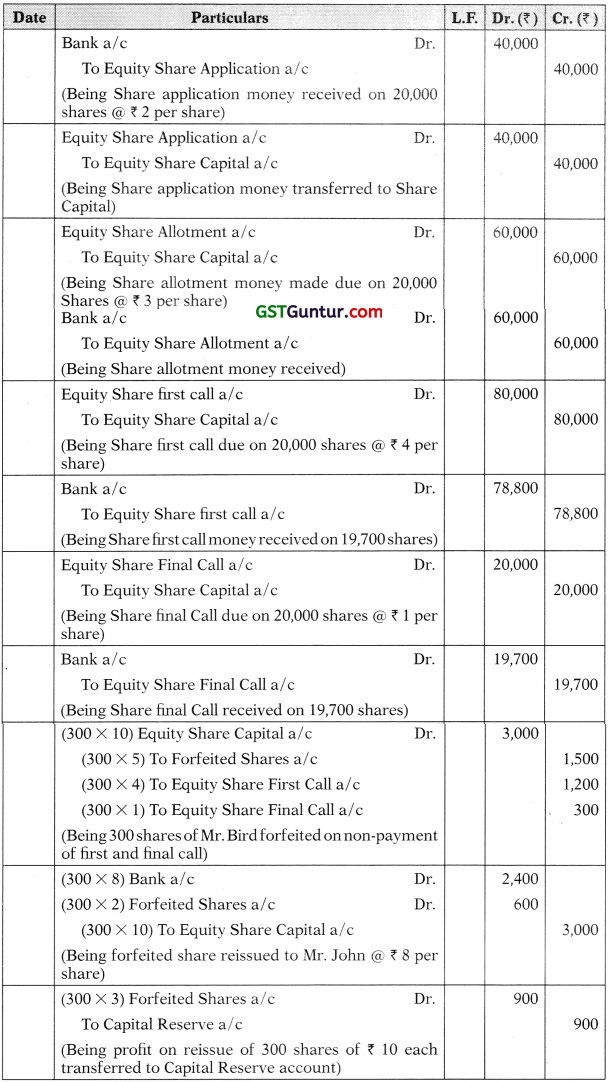
Question 6(b).
Y Company Limited issue 10,000 12% Debentures of the nominal value of ₹ 60,00,000 as follows:
(i) To a vendor for purchase of fixed assets worth ₹ 13,00,000 – ₹ 15,00,000 nominal value.
(ii) To sundry persons for cash at 9096 of nominal value of ₹ 30,00,000.
(iii) To the banker as collateral security for a loan of ₹ 14,00,000 – ₹ 15,00,000 nominal value.
You are required to pass necessary Journal Entries. (5 Marks)
Answer:
In the books of Y Company Ltd.
Journal Entries

Question 6(c).
Discuss the factors taken into consideration for calculation of depreciation. (5 Marks)
Answer:
The elements relevant for deciding the rate/amount of depreciation are:
- Cost of acquisition (Costs necessary to put an asset into usable condition)
- The estimated life of the asset
- Estimated scrap value at the end of its life
